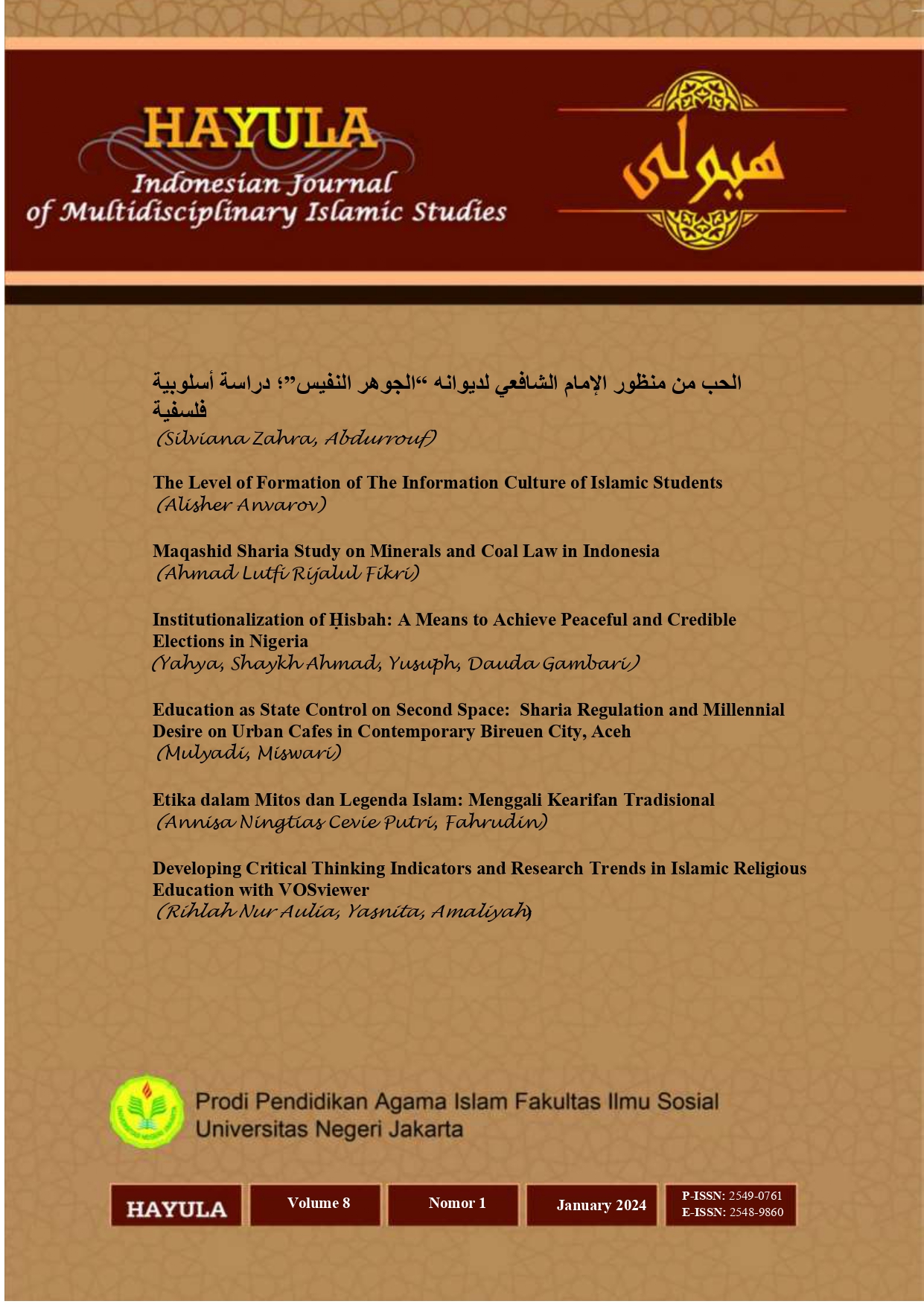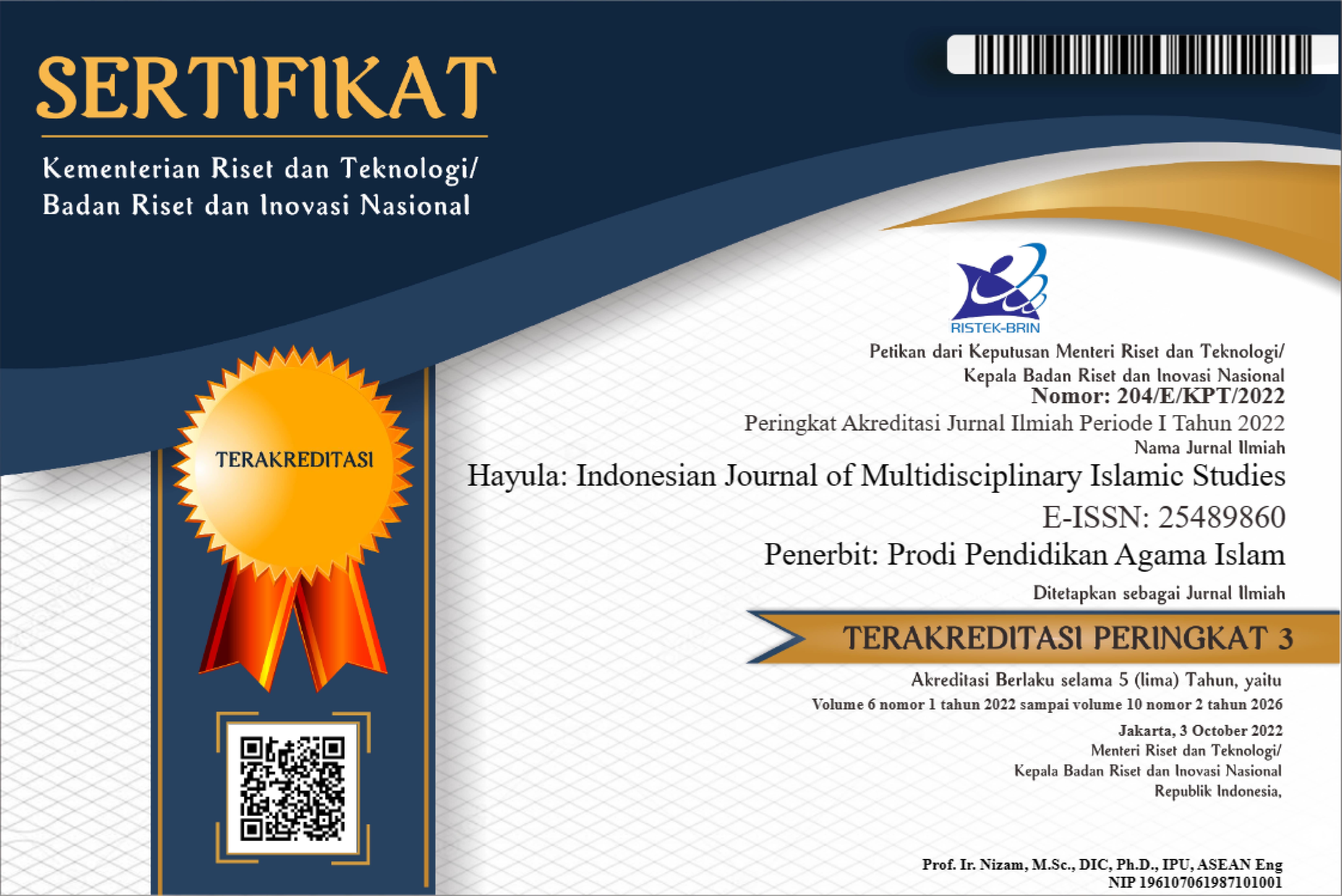Circulation of the Book of Al-Tuhfah Al-Mursalah Ila Ruh Al-Nabi: Translocality Study and Its Impact on Aceh's Muslim Community
DOI:
https://doi.org/10.21009/hayula.009.01.05Keywords:
Acehnese Muslim Community, Translocality, Tuhfah al-Mursalah, SufismAbstract
This article examines the circulation, transnationality, and contribution of Tuhfah al-Mursalah in Aceh, which played a significant role in the development of Sufism and the Islamization of Indonesia in the 17th century. This research adopts a descriptive-analytical library research method with a qualitative approach. This approach was chosen to explore the dissemination and contribution of Tuhfah al-Mursalah to the advancement of Muslims and intellectual and spiritual development in Indonesia. Indirectly, this research also uses a historical study approach. The findings in this study indicate that the teachings of the seven grades of being (martabat tujuh) have been known by Syamsuddin al-Sumtrani and the Acehnese since the year 1601. Historical indications show that the work has played a significant role in shaping the tradition of Sufism in the archipelago. The process of adaptation and contextualization of Tuhfah al-Mursalah in Aceh shows complex translocal dynamics. The existence of Sufism teachings simultaneously contributed to the emergence of local traditions, such as “adat bak po teumeureuhom, hukom bak syiah kuala” showing the relationship between adat and sharia law. This phrase shows how the Acehnese were able to combine local traditions with the Islamic faith, so that adat and Islamic law were considered as two sides of the same coin, rather than two different things. This process involved linguistic and cultural translation, in which the ideas of the book were adapted to local understandings and contexts. Acehnese scholars also reinterpreted its contents using terms and analogies relevant to local traditions and culture. The presence and teachings of the book also drew comments and criticism from several scholars. Nuruddin ar-Raniri was the most vocal critic of the book's teachings. He considered the teachings of Martabat Tujuh al-Sumatrani as heretical and heterodox.
References
Abdullah, Z., & Zainuddin. (2019). Tanbih Al-Masyi Questioning Wahdatul Wujud: The Case of Abdurrauf Singkel in Aceh in the 17th Century by Oman Fathurahman (Book Review). Mumtaz: Journal of Qur'an and Islamic Studies, 3(2), 280–288. https://doi.org/10.36671/mumtaz.v3i2.45
Afrianti, D. (2016). Sufism scholars network in the Middle East, India, and Indonesia. International Journal of Nusantara Islam, 4(1), 79–92. https://doi.org/10.15575/ijni.v4i1.1226
Anwar, M. K. (2016). The role of ulama in the archipelago in realizing religious harmonization. Fikrah, 4(1), 80. https://doi.org/10.21043/fikrah.v4i1.1621
Arwansyah, & Ahmad Shah, F. (2015). The role of Shaykh Nawawi Al-Bantani in the spread of Islam. Contextuality: Journal of Socio-Religious Research, 30(1), 69–87.
Astuti, H. J. P. (2017). Islam Nusantara: A religious argument in a cultural frame. INJECT: Interdisciplinary Journal of Communication, 2(1).
Asy’ari, H. (2018). The European Renaissance and the transmission of Islamic science to Europe. JUSPI (Journal of the History of Islamic Civilization, 2(1), 1. https://doi.org/10.30829/j.v2i1.1792
Azra, A. (2004). The Middle East and Archipelago Ulema Network in the XVII & XVIII centuries: The roots of Indonesian Islamic renewal (2nd ed.). Jakarta: Kencana.
Badaruddin, F. (2021). Tuhfah Al-Mursalah Ila Ruh al-Nabiy as the source of the doctrine seven grades of being in the Malay-Indonesian Archipelago. Teosofia: Indonesian Journal of Islamic Mysticism, 10(1), 59–74. https://doi.org/10.21580/tos.v10i1.8580
Bruinessen, M. V. (1995). The yellow book, Islamic boarding school, and tarekat: Islamic traditions in Indonesia (Cet. 1). Bandung: Mizan Publishers.
Handoyo, B. (2022). The concept of Wahdatul Manifests in the eyes of Sheikh Syamsuddin As-Sumatrani. Ta'wiluna: Journal of Qur'anic Science, Islamic Interpretation and Thought, 3(1), 127–152. https://doi.org/10.58401/takwiluna.v3i1.758
Daroini, M. (2022). Teaching the seven dignity knowledge in the book of “Topah” through oral tradition in Javanese people. Ta'wiluna: Journal of Qur'anic Science, Islamic Interpretation and Thought, 2(1).
Drewes, G. W. J. (1959). Review of Malay Sufism: As illustrated in an anonymous collection of 17th-century tracts. Bijdragen Tot de Taal-, Land- En Volkenkunde, 115(3), 280–304.
Fathurrahman, O. (2011). History of disbelief and marginalization of religious understanding in Malay and Java.
Fathurrahman, O. (n.d.). Indonesian philology: Theories and methods (1st ed.). Jakarta: Kencana.
Greiner, C., & Sakdapolrak, P. (2013). Translocality: Concepts, applications and emerging research perspectives. Geography Compass, 7(5), 373–384. https://doi.org/10.1111/gec3.12048
Hendra, T., Nur Adzani, S. A., & Muslim, K. L. (2023). Islamic da'wah and local cultural wisdom: Concepts and strategies for spreading Islamic teachings. Journal of Da'wah, 2(1), 65–82. https://doi.org/10.32939/jd.v2i1.2660
Ismail, F. (2022). The existence of Acehnese Islamic culture towards the integrity of Indonesian culture. Sustainable Development, 1(1).
Iswanto, A. (2013). Intellectual history of Nusantara ulama: Reformulation of tradition in the midst of change. Journal of Religious Literature, 11(2), 455. https://doi.org/10.31291/jlk.v11i2.77
Jalil, M. N. A., & Alias, M. (2020). Nur al-Din al-Raniri’s selected commentaries on other religions in the 17th-century Malay world. Journal of Al-Tamaddun, 15(1), 147–155. https://doi.org/10.22452/JAT.vol15no1.10
Johns, A. H. (1957). Malay Sufism: As illustrated in an anonymous collection of 17th-century tracts. Journal of the Malayan Branch of the Royal Asiatic Society, 30(2), 3–111.
Johns, A. H. (1993). Islamization in Southeast Asia: Reflections and reconsiderations with special reference to the role of Sufism. Japanese Journal of Southeast Asian Studies, 31(1), 43–61. https://doi.org/10.20495/tak.31.1_43
Makhmudov, O. V. (2022). The concept of "medieval European translation centers" and the register of Latin manuscript. Journal of Pharmaceutical Negative Results, 13(9). https://doi.org/10.47750/pnr.2022.13.S09.622
Miharja, D. (2014). The contact of Islamic religion with Indonesian indigenous culture. MIQOT: Journal of Islamic Sciences, 38(1). https://doi.org/10.30821/miqot.v38i1.97
Miswar, A. (2016). Patterns of tafsir thinking in the early development of the tafsir tradition in the archipelago (Hamzah al-Fansuri, Syamsuddin al-Sumatrani, and Abd Rauf al-Singkel). Journal of Rihlah, 4(1).
Munip, A. (2010). The transmission of Middle Eastern knowledge to Indonesia: A study on the translation of Arabic books in Indonesia 1950–2004. Jakarta: The Ministry of Religion of the Republic of Indonesia, the Agency for Research and Development and Training, the Center for Research and Development of Religious Literature.
Nasution, I. F. A. (2017). Termination of Wahdatul Wujud in Islamic civilization in Aceh: Critical analysis of Ithaf al-Dhaki, the works of Ibrahim Kurani. Addin, 11(2).
Qomar, M. (2016). Islam Nusantara: An alternative model of Islamic thinking, understanding, and practice. El-Harakah, 17(2), 198. https://doi.org/10.18860/el.v17i2.3345
Ramadhan, F., Fatmawati, Handayani, & Lestari. (2022). Sufism of Wahdat Al-Wujud (Wujudiyah) Sheikh Syamsuddin As-Sumatrani: Tarekat, teachings and practices in West Sumatra in the 16th and 17th centuries AD. Journal of Islamic Sciences, 1(3).
Riddell, P. (1990). Transferring a tradition: Abd al-Ra’ūf al-Singkili’s rendering into Malay of the Jalālayn commentary. Monograph Series. Centers for South and Southeast Asia Studies, University of California at Berkeley.
Riddell, P. G. (2001). Islam and the Malay-Indonesian world: Transmission and responses. London: Hurst & Company.
Rusdiyanto, & Musafar. (2018). The teachings of manifestation according to Nuruddin Ar-Raniri. Portrait of Thought, 22(1). https://doi.org/10.30984/pp.v22i1.756
Sahlan, M., Fajarni, S., Ikramatoun, S., Kamil, A. I., & Ilham, I. (2019). The roles of ulama in the process of post-conflict reconciliation in Aceh. Society, 7(2), 251–267. https://doi.org/10.33019/society.v7i2.106
Supriati, E. (2022). The contribution of Nusantara ulema to Islamic science in Indonesia: A case study of manuscript inventory of Tremas and Tebuireng Islamic boarding schools. Muslim Heritage, 7(1). https://doi.org/10.21154/muslimheritage.v7i1.3625
Shahid, A. (2015). History of Indonesian Islamic culture: Tradition, intellectual, and social (2nd ed.). Jakarta: Directorate of History and Cultural Values, Directorate General of Culture, Ministry of Education and Culture.
Downloads
Published
How to Cite
Issue
Section
License
Copyright (c) 2025 Daud Lintang, Kombang Tua Siregar, Randy Putra Alamsyah (Author)

This work is licensed under a Creative Commons Attribution 4.0 International License.
Authors who publish with this Journal agree to the following terms:
- Author retain copyright and grant the journal right of first publication with the work simultaneously licensed under a creative commons attribution licensethat allow others to share the work within an acknowledgement of the work’s authorship and initial publication of this journal.
- Authors are able to enter into separate, additional contractual arrangementfor the non-exclusive distribution of the journal’s published version of the work (e.g. acknowledgement of its initial publication in this journal).
- Authors are permitted and encouraged to post their work online(e.g. in institutional repositories or on their websites) prior to and during the submission process, as it can lead to productive exchanges, as well as earlier and greater citation of published works.
Users/public use of this website will be licensed to CC BY







